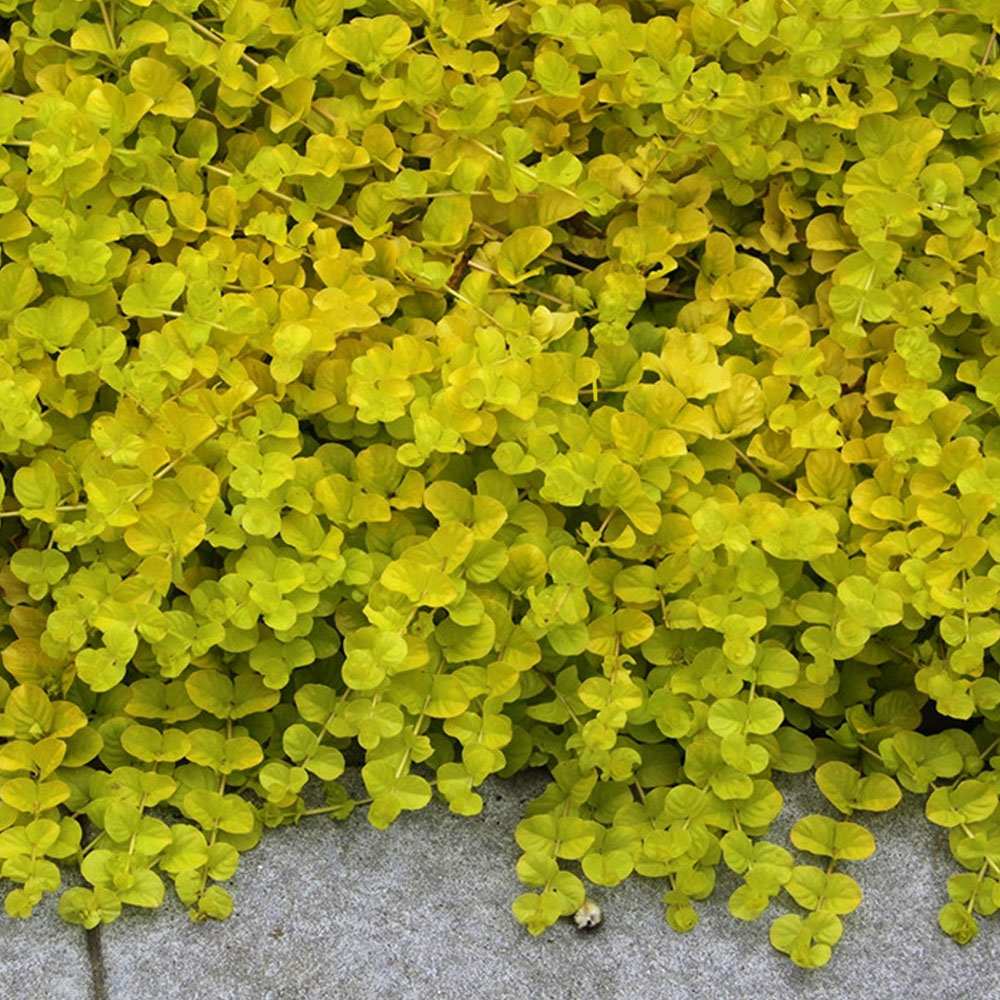No products in the cart.
Lysimachia nummularia Goldilocks
A golden ground cover for moist soil.
Rated 0 out of 5
0 customer reviews4,90 €
Only 10 item(s) left in stock!
SKU: pda440
Category: Balcony-Friendly, Bees and Butterflies, Bouquet, Distillations, Fragrant, Frost Hardy, Ground Cover, Medicinal, Rewild

Lysimachia nummularia Goldilocks
4,90 €
Only 10 item(s) left in stock!
Lysimachia nummularia Goldilocks, known as creeping Jenny or moneywort, is a small trailing perennial that lights up even the darkest of corners.
The cultivar ‘Goldilocks’ is especially radiant: its round, coin-shaped leaves glow with a golden hue that brightens the damp corners of gardens and the edges of ponds.
The plant trails gracefully along the ground, rooting as it goes, forming soft carpets that glimmer in morning light.
The leaves are round and golden, trailing down from baskets or across moist soils to form a ground cover.
The flowers are little and yellow and cup shaped.
In summer, it adds delicate yellow flowers that blend almost seamlessly with the foliage, a quiet continuation of its golden theme.
👨🌾GARDENING TIPS👨🌾: Lysimachia nummularia Goldilocks
- 🚫 Drought Tolerance: Lysimachia nummularia Goldilocks has a low drought tolerance but a high tolerance for humidity – sometimes the future is not dry, it is very very damp. It depends where your garden is!
- For drought-tolerant groundcovers > you might consider something like Sedum or Thyme varieties instead
The Tale & The Botany : Lysimachia nummularia Goldilocks
The name Lysimachia reaches back to ancient Greece.
It’s said that King Lysimachus of Thrace, a companion of Alexander the Great, first discovered the calming powers of a plant from this genus.
When a bull grew wild and uncontrollable, he used the herb to pacify it—hence the name meaning “loosening strife” or “ending conflict.” From this legend came the belief that Lysimachia could soothe anger and bring peace, both to animals and to people.
The second part of its name, nummularia, comes from the Latin nummus, meaning “coin,” a reference to the plant’s round, shining leaves.
Since then, it has long been linked with prosperity and good fortune.
Folk gardeners once planted moneywort near doorways or wells, believing it would draw abundance into the home and calm troubled hearts.
In stables, it was said to quiet restless horses and oxen—living up to its name as “loose-strife.”
Myths and Legends
Lysimachia nummularia Goldilocks, with its vivid golden tones, naturally invites more recent associations.
Its name recalls the fairy-tale heroine who found things “just right,” and gardeners often find this plant much the same: resilient but gentle, bright yet soothing.
In some modern gardens, people call it the “fairy’s gold carpet,” a nod to how it glows in twilight, as though enchanted.
‘Goldilocks’ is a cultivar that features particularly round, golden-yellow leaves.
Ecology
This species belongs to the primrose family, Primulaceae, and hails from damp meadows and stream banks across Europe.
It thrives in moist soil and partial sun but can handle both shade and full light, changing its tone from lime to deep gold depending on where it grows.
Though it spreads quickly—sometimes too quickly—it is beloved for the way it brings light into shaded spaces and weaves between stones or along water’s edge.
Through centuries, Lysimachia nummularia Goldilocks has moved quietly between worlds—the practical and the poetic, the wild stream and the manicured bed.
Other names
Creeping Jenny
Loose Strife
Origin
Europe
Similaire
| Weight | 0,5 kg |
|---|---|
| Flower Color | 🟡 Yellow |
| Flowering | June, July, August |
| Exposure | Half Sun/Half Shade |
| Frost Tolerance | -25°C to -30°C |
| Soil | Cool, Moist |
| Size | 0.08m H x 1m W |
Reviews
0
Rated 0 out of 5
0 customer reviews5
0
4
0
3
0
2
0
1
0
Only logged in customers who have purchased this product may leave a review.
You may also like…
Carex pendula
A perennial grass ideal for humid banks and shady areas.
A perennial grass ideal for humid banks and shady areas.
Rated 0 out of 5
Related Products
Melissa officinalis
A perennial plant in the mint family that is adored by bees, royal families and tea drinkers.
A perennial plant in the mint family that is adored by bees, royal families and tea drinkers.
Rated 0 out of 5
Euphorbia cyparissias Clarice Howard
A Euphorbia that resembles a soft little cyprus tree
A Euphorbia that resembles a soft little cyprus tree
Rated 0 out of 5
Glechoma hederacea
A sweet smelling ground cover, producing little blue flowers all summer long.
A sweet smelling ground cover, producing little blue flowers all summer long.
Rated 0 out of 5
Hieracium maculatum Leopard
A native perennial with blue-green leaves and a tall yellow flower
A native perennial with blue-green leaves and a tall yellow flower
Rated 0 out of 5
Mentha x piperita ‘Chartreuse’
A spicy mint, known for its use in the production of liqueurs and herbal teas.
A spicy mint, known for its use in the production of liqueurs and herbal teas.
Rated 0 out of 5
Cerastium tomentosum var. columnae
A grey-green spreading ground cover from the mountains.
A grey-green spreading ground cover from the mountains.
Rated 0 out of 5
Erigeron kavinskianus
A daisy-like carpet of flowers
A daisy-like carpet of flowers
Rated 0 out of 5
Stachys byzantina
Silky white-grey leaves and tall striking flowers
Silky white-grey leaves and tall striking flowers
Rated 0 out of 5
Tradescantia Blushing Bride
Gorgeous blushes of pink and white that appear in the coldest nights.
Gorgeous blushes of pink and white that appear in the coldest nights.
Rated 0 out of 5
Euphorbia myrsinites
Known for its draping form of silver-gray foliage and radiant blooms.
Known for its draping form of silver-gray foliage and radiant blooms.
Rated 0 out of 5
Vinca minor
Looping elegance and ability to form a low flowering ground cover
Looping elegance and ability to form a low flowering ground cover
Rated 0 out of 5
Hellebore argutifolius
Winter flowering perennial with marbled blue-green leaves
Winter flowering perennial with marbled blue-green leaves
Rated 0 out of 5
Artemisia Valerie Finnis
A semi-evergreen, aromatic variation on the theme of Artemisia.
A semi-evergreen, aromatic variation on the theme of Artemisia.
Rated 0 out of 5
Echinacea purpurea
A perennial with purple flowers all summer long
A perennial with purple flowers all summer long
Rated 0 out of 5
Delosperma cooperi
A dwarf perennial known for its vermillion colored flowers
A dwarf perennial known for its vermillion colored flowers
Rated 0 out of 5
Kalanchoe daigremontiana
A toothy succulent from Madagascar, known as the Mother of Thousands.
A toothy succulent from Madagascar, known as the Mother of Thousands.
Rated 0 out of 5
Sedum album
A low, multi-color ground cover.
A low, multi-color ground cover.
Rated 0 out of 5
Trachelospermum asiaticum ‘Ogon Nishiki’
Jasmine with colorful foliage and lovely white flowers in summer
Jasmine with colorful foliage and lovely white flowers in summer
Rated 0 out of 5
recent view product
Erinus alpinus ‘Dr Hähnle’
A cushion covered in carmine flowers
A cushion covered in carmine flowers
Rated 0 out of 5
Sedum spurium Tricolor
A tricolored mat forming sedum
A tricolored mat forming sedum
Rated 0 out of 5
Vinca minor
Looping elegance and ability to form a low flowering ground cover
Looping elegance and ability to form a low flowering ground cover
Rated 0 out of 5
Achillea millefolium Terracotta
A flowering perennial known for its flowers that shift in color from bright orange to soft terracotta tones as they age.
A flowering perennial known for its flowers that shift in color from bright orange to soft terracotta tones as they age.
Rated 0 out of 5
Windowbox: Kalanchoe
Windowboxes made to order
Windowboxes made to order
Rated 0 out of 5












































There are no reviews yet.